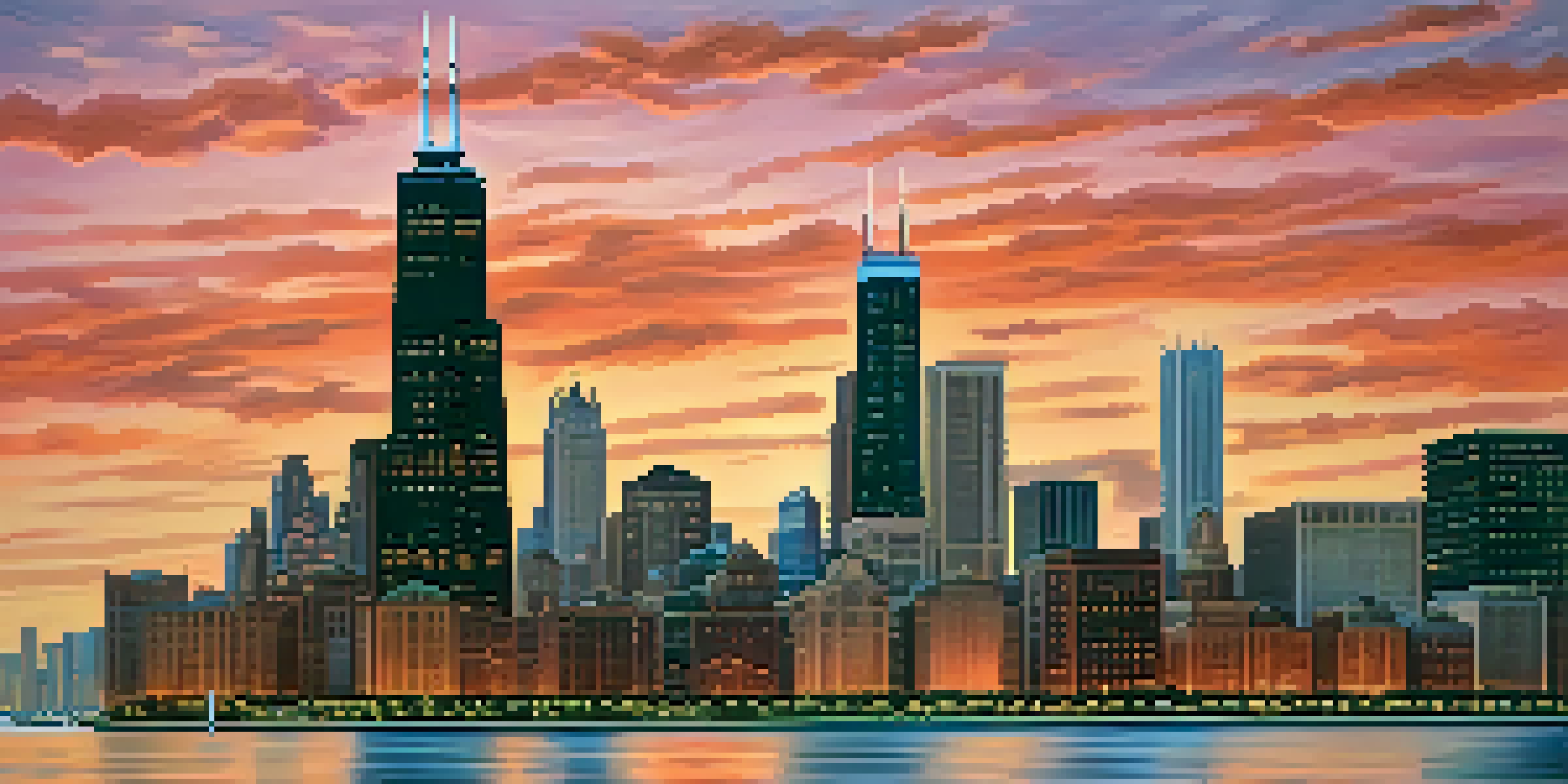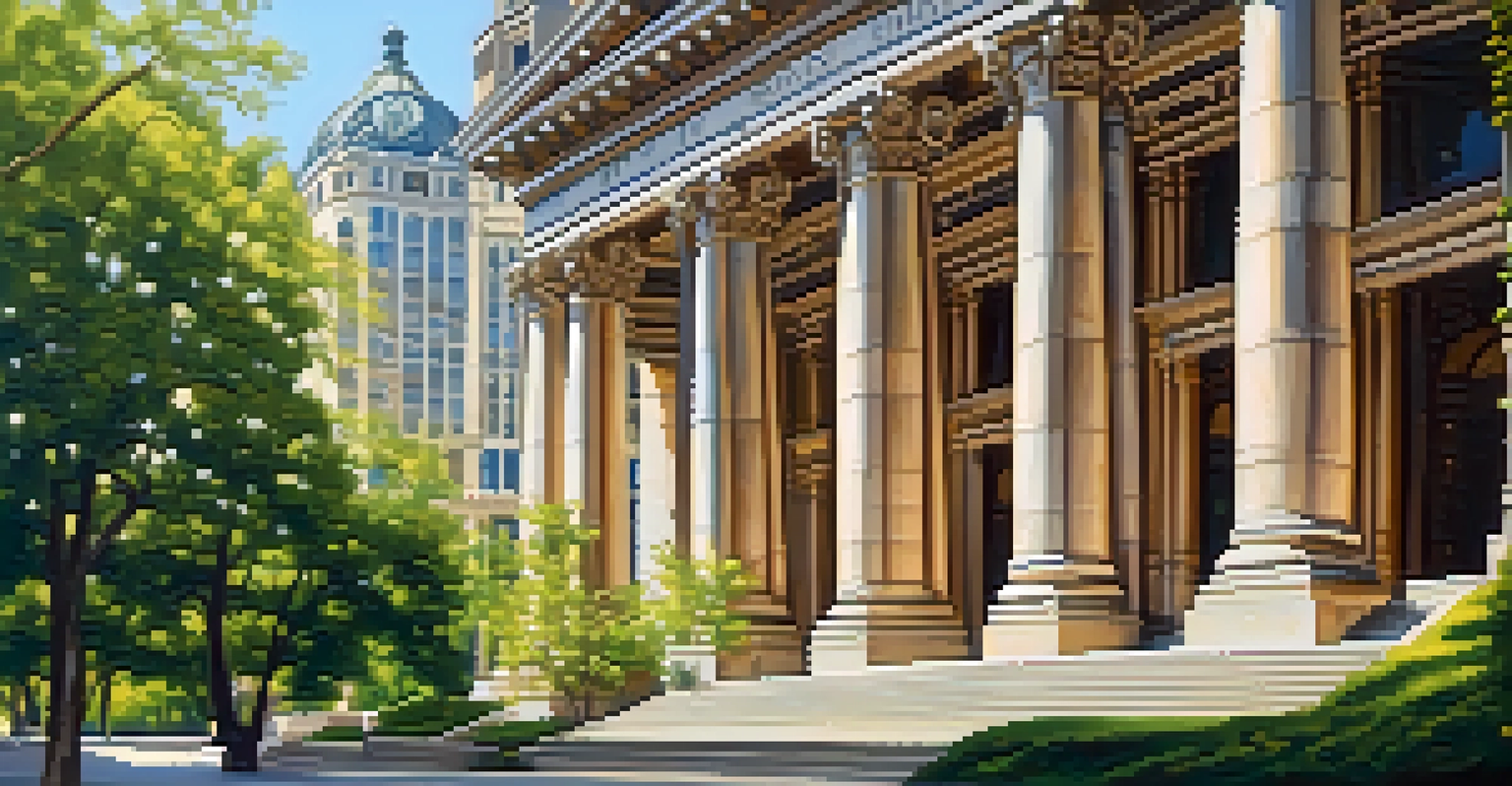The Architectural Styles of Chicago: A Comprehensive Guide

The Birth of Chicago Architecture: A Historical Overview
Chicago's architectural journey began in the aftermath of the Great Fire of 1871, which devastated much of the city. This catastrophic event provided a unique opportunity for architects to rebuild and innovate, leading to the development of entirely new styles. The city became a canvas for creativity, where the old met the new, and a variety of architectural movements flourished.
Architecture is the learned game, correct and magnificent, of forms assembled in the light.
As the city rebuilt, influential figures like Louis Sullivan and Frank Lloyd Wright emerged, each bringing their unique vision to the table. Sullivan, often called the 'father of skyscrapers,' emphasized functionality and ornamentation, while Wright focused on harmonizing structures with their surroundings. Their works set the tone for Chicago's architectural landscape, showcasing a blend of beauty and practicality.
Today, Chicago stands as a testament to this rich history, boasting a skyline filled with buildings that reflect various styles. From the towering skyscrapers of the Loop to the charming bungalows of the neighborhoods, each structure tells a story of resilience and innovation, making it a fascinating subject for architecture enthusiasts.
The Chicago School: Embracing the Skyscraper
The Chicago School of architecture emerged in the late 19th century, marking a significant shift in urban design. This movement is characterized by the use of steel frames, allowing for taller buildings that could reach unprecedented heights. The emphasis on functionality was evident, with architects prioritizing the needs of urban dwellers while embracing new construction technologies.

One of the most iconic examples of this style is the Home Insurance Building, completed in 1885, often regarded as the world's first skyscraper. Its innovative use of steel and glass set the stage for future developments in urban architecture. The Chicago School not only transformed the skyline but also influenced architects worldwide, pioneering the modern skyscraper.
Chicago's Architectural Evolution
Chicago's architecture has transformed dramatically since the Great Fire of 1871, leading to innovative styles and iconic structures.
As we stroll through the Loop, the legacy of the Chicago School becomes clear. Buildings like the Monadnock and the Auditorium Theatre showcase the movement's principles, with their bold facades and functional designs. This style represents a pivotal moment in architectural history, where ambition and innovation reshaped the urban landscape.
Beaux-Arts Architecture: A Touch of Elegance
Beaux-Arts architecture, with its grandiose and decorative style, made a significant impact on Chicago in the late 19th and early 20th centuries. This movement drew inspiration from classical European architecture, emphasizing symmetry, elaborate details, and monumental scale. The style often incorporates elements like columns, domes, and intricate sculptures that evoke a sense of grandeur.
The best architect is not the one who knows the most, but the one who understands the most.
The Chicago Public Library, designed by the renowned architect Bertram Goodhue, is a prime example of Beaux-Arts influence. Its majestic facade and ornate interior reflect the movement's emphasis on beauty and sophistication. This style was not just about aesthetics; it aimed to inspire civic pride and cultural appreciation through its monumental structures.
As we explore the city, several buildings stand as testaments to Beaux-Arts architecture. The Field Museum and the Art Institute of Chicago are both exemplary, showcasing the style's elaborate detailing and commitment to grandeur. These buildings invite visitors to appreciate not only their beauty but also the cultural significance they embody.
Art Deco: A Modern Twist on Elegance
Art Deco emerged in the 1920s and 1930s, bringing a modern twist to architectural design that celebrated luxury, glamour, and technological progress. This style is characterized by bold geometric shapes, vibrant colors, and decorative motifs inspired by the machine age. In Chicago, Art Deco became synonymous with the city's skyscrapers, adding a unique flair to the skyline.
One of the most iconic examples of Art Deco in Chicago is the Chicago Board of Trade Building, with its striking ornamentation and towering presence. Its design reflects the optimism of the era, showcasing the city's economic power and ambition. The use of materials like terra cotta and polished stone further enhances its elegance, making it a standout in the architectural landscape.
Influence of Architectural Movements
Various architectural movements, from the Chicago School to Postmodernism, have shaped the city's skyline and urban identity.
As we wander through the city, the influence of Art Deco is evident in several buildings, including the iconic Merchandise Mart and the Palmolive Building. These structures not only capture the essence of the style but also demonstrate how Chicago embraced modernity while honoring its architectural heritage.
Modernism: A Shift Towards Simplicity
Modernism emerged in the mid-20th century as a response to the ornate styles that preceded it, favoring simplicity, functionality, and a connection to nature. This architectural movement sought to strip away unnecessary embellishments, focusing instead on clean lines and open spaces. In Chicago, modernist architects left an indelible mark on the city's skyline, reimagining urban living.
The work of architects like Ludwig Mies van der Rohe exemplifies the modernist ethos, particularly with buildings such as the Seagram Building. His approach emphasized transparency and the use of industrial materials, creating a sense of harmony between interior and exterior spaces. This philosophy not only transformed the way buildings were designed but also how people interacted with their environments.
As we explore modernist architecture in Chicago, we find landmarks like the IIT Crown Hall and the S.R. Crown Hall, both showcasing the principles of minimalism and functionality. These structures reflect a shift in architectural thinking, emphasizing that less can indeed be more, while providing spaces that foster creativity and collaboration.
Postmodernism: A Playful Return to Ornamentation
Postmodernism emerged as a reaction against the starkness of modernism, reintroducing ornamentation and historical references into architectural design. This movement, which gained traction in the late 20th century, celebrates a playful and eclectic approach to building. In Chicago, postmodern architects began to experiment with color, form, and historical motifs, resulting in vibrant and eye-catching structures.
The AT&T Building, designed by Philip Johnson, is a quintessential example of postmodern architecture in Chicago. Its distinctive Chippendale-style top and playful use of classical elements showcase the movement's departure from the austere lines of modernism. This building invites viewers to appreciate the blend of old and new, sparking conversations about the role of history in contemporary design.
Focus on Sustainable Design
Recent trends in sustainable architecture reflect Chicago's commitment to eco-friendly practices and innovation for the future.
As we navigate the city, other postmodern gems like the Harold Washington Library and the United States Postal Service Building further illustrate this style's impact. These buildings not only stand out visually but also invite us to engage with their stories, reminding us that architecture can be both functional and fun.
Sustainable Architecture: Building for the Future
In recent years, sustainable architecture has gained momentum, reflecting a growing awareness of environmental issues and a desire for eco-friendly design. Chicago has embraced this movement wholeheartedly, with architects focusing on energy efficiency, sustainable materials, and green spaces. This approach not only benefits the planet but also enhances the quality of life for residents.
One of the shining examples of sustainable architecture in Chicago is the Gary Comer Youth Center, which incorporates green roofs, natural ventilation, and rainwater harvesting. This building serves as a model for how architecture can positively impact the environment while providing functional spaces for the community. The emphasis on sustainability is not just a trend; it's a necessity for future generations.

As we explore the city's commitment to sustainability, we can see its influence in various projects, including the LEED-certified buildings that dot the skyline. These structures exemplify a forward-thinking approach to design, where aesthetics and environmental responsibility go hand in hand. Chicago's dedication to sustainable architecture sets a powerful precedent for cities around the world.
The Future of Chicago Architecture: Trends and Innovations
As we look ahead, the future of Chicago's architecture is poised to be shaped by technological advancements and evolving urban needs. Architects are increasingly experimenting with innovative materials and cutting-edge design techniques that push the boundaries of what's possible. This dynamic landscape promises to create even more iconic structures that will define the city's skyline in the years to come.
One exciting trend is the rise of smart buildings that integrate technology for improved energy management and user experience. These structures are designed to adapt to their environment, enhancing sustainability and providing a higher quality of life for occupants. Chicago's commitment to innovation positions it as a leader in the architectural realm, inspiring other cities to follow suit.
As we embrace these changes, Chicago's architectural narrative continues to evolve, blending tradition with modernity. The city's rich history serves as a foundation for future developments, ensuring that each new building contributes to the ongoing story of Chicago's skyline. With a focus on sustainability and innovation, the city is set to remain a vibrant hub of architectural exploration.